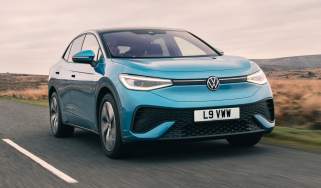Volkswagen ID.7 review - Boot space, practicality & boot dimensions
“The Volkswagen ID.7 is a large car, with a big boot and plenty of interior space”
The Volkswagen ID.7 is a fairly large car that’s closer to the BMW i5 and Mercedes EQE in size than it is to the Tesla Model 3 or Polestar 2. It gets a handy hatchback tailgate that makes it easier to load items in and out of, rather than the saloon boot of the Model 3, so it pips that car in terms of practicality. Soon it will be available in an estate ‘Tourer’ bodystyle, increasing practicality with even more boot space.
One of Volkswagen’s priorities when designing the ID.7 was interior space, and there’s lots of legroom not only for front passengers, but back-seat passengers too. The panoramic roof increases the sense of space and also improves headroom for occupants – the ‘Smart Glass’ option also allows for this toggle between opaque and transparent at the touch of a button.
There are plenty of storage solutions on the inside of the ID.7, too. There’s a large compartment with two sliding lids in between the front seats, as well as split folding armrests with integrated storage.
| Size comparison | |||
| Model | Length | Width | Height |
| Volkswagen ID.7 | 4,961mm | 1,862mm | 1,536mm |
| Polestar 2 hatchback | 4,606mm | 1,859mm | 1,473mm |
| Tesla Model 3 | 4,720mm | 1,850mm | 1,441mm |
| Hyundai Ioniq 6 | 4,855mm | 1,880mm | 1,495mm |
Does the Volkswagen ID.7 have a big boot?
The Volkswagen ID.7’s boot space is generous at 532 litres with the seats up – unsurprisingly given the car’s large proportions, that beats the Tesla Model 3, Hyundai Ioniq 6 and Polestar 2, as well as the BMW i5. Annoyingly, although the boot features a more practical hatchback style, it’s awkwardly shaped and narrow. There’s also no dedicated area for the charging cables up front.
| Boot space comparison | |
| Model | Boot space |
| Tesla Model 3 | 542 litres |
| Volkswagen ID.7 | 532 litres |
| Polestar 2 | 440 litres |
| Hyundai Ioniq 6 | 401 litres |
Is the Volkswagen ID.7 a good tow car?
The ID.7 is capable of towing, although you won’t be hitching up any large caravans or horseboxes. Pick the Pro S version and it can pull a 1,000kg braked trailer, while the GTX ups this to 1,200kg thanks to its all-wheel drive. A tow bar is an optional extra costing around £1,000.


















